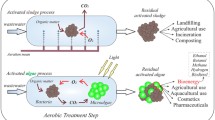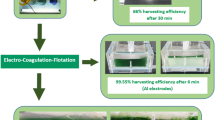Abstract
The use of microalgae in biological wastewater treatment has been widely studied. However, there is a dearth of information about estimating the microalgae and bacteria concentrations. In order to maintain a stable algal-bacterial system, it is necessary to quantify both the algal and bacterial biomasses. Typically, microalgae and bacteria from flocs in activated sludge contribute to better biomass settleability. However, flocs cause problems when it comes to estimating the individual biomass concentrations of microalgae and bacteria in a symbiotic algae-bacteria aggregate. This study aimed to find the best disintegration treatment with low influence on the viability of the microalgal cell determined by its photosynthetic activity. In the present work, biological (enzyme solution), chemical (formaldehyde), mechanical (glass bead-beating), and physical (sonication) treatments were performed on microalgae–bacteria flocs (ALBA flocs) to disintegrate the community as a pre-treatment step in order to develop a method for estimating the algal and bacterial concentration and to quantify the degree of disintegration. The effectiveness of the methods to disintegrate ALBA flocs in descending order are the following: sonication, bead-beating, formaldehyde and enzyme application. Sonication treatment (40 W, 6 min) showed the best disintegration performance of the microalgal-bacterial flocs, up to 90 % with 17 % loss of the algal photosynthetic activity. Bead-beating (3 mm diameter, 80 s) achieved 80 % of disintegration with only 6 % loss of its photosynthetic activity. These results demonstrate the possibility of mild disintegration of compact ALBA flocs without having any adverse impact on the microalgae cell. After these treatments, it becomes possible to estimate the individual biomass concentrations of algae and bacteria manually such as with a cell-counting chamber.






Similar content being viewed by others
References
Adav SS, Lee DJ (2008) Extraction of extracellular polymeric substances from aerobic granule with compact interior structure. J Hazard Mater 154:1120–1126
Chisti Y, Mooyoung M (1986) Disruption of microbial-cells for intracellular products. Enzyme Microb Tech 8:194–204
Comte S, Guibaud G, Baudu M (2006) Relations between extraction protocols for activated sludge extracellular polymeric substances (EPS) and EPS complexation properties part I. Comparison of the efficiency of eight EPS extraction methods. Enzyme Microb Tech 38:237–245
Cosgrove J, Borowitzka MA (2011) Chlorophyll fluorescence terminology: an introduction. In: Suggett DJ, Prásil O, Borowitzka MA (eds) Chlorophyll a fluorescence in aquatic sciences: methods and applications. Springer, Dordrecht, pp. 1–17
Cromar NJ, Fallowfield HJ (1992) Separation of components of the biomass from high-rate algal ponds using Percoll® density gradient centrifugation. J Appl Phycol 4:157–163
Cromar NJ, Fallowfield HJ (2003) Use of image analysis to determine algal and bacterial biomass in a high rate algal pond following Percoll® fractionation. Water Sci Technol 48:53–60
Doucha J, Livansky K (2008) Influence of processing parameters on disintegration of Chlorella cells in various types of homogenizers. Appl Microbiol Biot 81:431–440
Guibaud G, Bordas F, Saaid A, D'abzac P, Van Hullebusch E (2008) Effect of pH on cadmium and lead binding by extracellular polymeric substances (EPS) extracted from environmental bacterial strains. Colloid Surface B 63:48–54
Guieysse B, Borde X, Munoz R, Hatti-Kaul R, Nugier-Chauvin C, Patin H, Mattiasson B (2002) Influence of the initial composition of algal–bacterial microcosms on the degradation of salicylate in a fed-batch culture. Biotechnol Lett 24:531–538
Gutzeit G, Lorch D, Weber A, Engels M, Neis U (2005) Bioflocculent algal–bacterial biomass improves low-cost wastewater treatment. Water Sci Technol 52:9–18
Halim R, Rupasinghe TWT, Tull DL, Webley PA (2013) Mechanical cell disruption for lipid extraction from microalgal biomass. Bioresource Technol 140:53–63
Hanelt D, Nultsch W (1995) Field studies of photoinhibition show non-correlations between oxygen and fluorescence measurements in the arctic red-alga Palmaria palmata. J Plant Physiol 145:31–38
Janczyk P, Franke H, Souffrant WB (2007) Nutritional value of Chlorella vulgaris: effects of ultrasonication and electroporation on digestibility in rats. Anim Feed Sci Technol 132:163–169
Joyce EM, King PM, Mason TJ (2014) The effect of ultrasound on the growth and viability of microalgae cells. J Appl Phycol 26:1741–1748
Kessler E, Czygan FC (1970) Physiologische und biochemische Beiträge zur Taxonomie der Gattung Chlorella IV. Verwertung organischer Stickstoffverbindungen. Arch Mikrobiol 70:211–216
Lau PS, Tam NFY, Wong YS (1995) Effect of algal density on nutrient removal from primary settled waste-water. Environ Pollut 89:59–66
Liu H, Fang HHP (2002) Extraction of extracellular polymeric substances (EPS) of sludges. J Biotechnol 95:249–256
Medina M, Neis U (2007) Symbiotic algal–bacterial wastewater treatment: effect of food to microorganism ratio and hydraulic retention time on the process performance. Water Sci Technol 55:165–171
Mercer P, Armenta RE (2011) Developments in oil extraction from microalgae. Eur J Lipid Sci Tech 113:539–547
Nielsen PH, Thomsen TR, Nielsen JL (2004) Bacterial composition of activated sludge—importance for floc and sludge properties. Water Sci Technol 49:51–58
Oswald WJ (1995) Ponds in the twenty-first Century. Water Sci Technol 31:1–8
Oswald WJ, Gotaas HB, Golueke CG, Kellen WR (1957) Algae in waste treatment. Sewage Ind Wastes 29:437–455
Pan XL, Liu J, Zhang DY, Chen X, Li LH, Song WJ, Yang JY (2010) A comparison of five extraction methods for extracellular polymeric substances (EPS) from biofilm by using three-dimensional excitation-emission matrix (3DEEM) fluorescence spectroscopy. Water SA 36:111–116
Park KY, Kweon J, Chantrasakdakul P, Lee K, Cha HY (2013) Anaerobic digestion of microalgal biomass with ultrasonic disintegration. Int Biodeter Biodegr 85:598–602
Park JY, Lee K, Choi SA, Jeong MJ, Kim B, Lee JS, Oh YK (2015) Sonication-assisted homogenization system for improved lipid extraction from Chlorella vulgaris. Renew Energ 79:3–8
Passos F, Hernandez-Marine M, Garcia J, Ferrer I (2014) Long-term anaerobic digestion of microalgae grown in HRAP for wastewater treatment. Effect of microwave pretreatment. Water Res 49:351–359
Rajasekhar P, Fan LH, Nguyen T, Roddick FA (2012) Impact of sonication at 20 kHz on Microcystis aeruginosa, Anabaena circinalis and Chlorella sp. Water Res 46:1473–1481
Shriwastav A, Mohmed J, Bose P, Shekhar M (2015) Deconvoluting algal and bacterial biomass concentrations in algal–bacterial suspensions. J Appl Phycol 27:211–222
Sponza DT (2003) Investigation of extracellular polymer substances (EPS) and physicochemical properties of different activated sludge flocs under steady-state conditions. Enzyme Microb Tech 32:375–385
Su YY, Mennerich A, Urban B (2012a) Comparison of nutrient removal capacity and biomass settleability of four high-potential microalgal species. Bioresource Technol 124:157–162
Su YY, Mennerich A, Urban B (2012b) Coupled nutrient removal and biomass production with mixed algal culture: impact of biotic and abiotic factors. Bioresource Technol 118:469–476
Su YY, Mennerich A, Urban B (2012c) Synergistic cooperation between wastewater-born algae and activated sludge for wastewater treatment: influence of algae and sludge inoculation ratios. Bioresource Technol 105:67–73
Sutherland IW (2001) Biofilm exopolysaccharides: a strong and sticky framework. Microbiology 147:3–9
Van den Hende S, Beelen V, Bore G, Boon N, Vervaeren H (2014a) Up-scaling aquaculture wastewater treatment by microalgal bacterial flocs: from lab reactors to an outdoor raceway pond. Bioresource Technol 159:342–354
Van den Hende S, Carre E, Cocaud E, Beelen V, Boon N, Vervaeren H (2014b) Treatment of industrial wastewaters by microalgal bacterial flocs in sequencing batch reactors. Bioresource Technol 161:245–254
Weinberger G, Hentschke C, Neis U, Ergünsel A, Pereira A (2012) Combined algal and bacterial waste water treatment for high environmental QUAlity effluents (ALBAQUA). http://www.ptspaper.de/fileadmin/PTS/PTSPAPER/06_Forschung/Dokumente/Forschungsprojekte/EU_ALBAQUA.pdf
Weinberger G, Bienert C, Pell L, Wieczorek N, Kuchta K, Zimmermann B, Vreuls C, Wilmot A, Pesoutova R, Hlavinek P (2015) Algae–Bacteria operation processes for waste water treatment and biomass production. http://www.cornet-albapro.eu/fileadmin/PTS/ALBAPRO/Dokumente/ALBAPRO_Final%20report.pdf
Wieczorek N, Kucuker MA, Kuchta K (2015) Microalgae–bacteria flocs (MaB-flocs) as a substrate for fermentative biogas production. Bioresour Technol 194:130–136
Yu XC, Dong T, Zheng YB, Miao C, Chen SL (2015) Investigations on cell disruption of oleaginous microorganisms: hydrochloric acid digestion is an effective method for lipid extraction. Eur J Lipid Sci Tech 117:730–737
Acknowledgment
The research project CORNET 83 EN of the co-operating research associations was funded by the following ministries within the programme of “promoting pre-competitive joint research” and carried out under the umbrella of the German Federation of Industrial Co-operative Research Associations (AiF). We would like to express our sincere thanks for this support. The cooperation of Paper Foundation (PTS) Germany and TUHH is greatly appreciated.
Author information
Authors and Affiliations
Corresponding author
Rights and permissions
About this article
Cite this article
Pell, L., Löhn, S., Weinberger, G. et al. Mild disintegration methods of microalgae–bacteria flocs from wastewater treatment. J Appl Phycol 29, 843–851 (2017). https://doi.org/10.1007/s10811-016-0978-1
Received:
Revised:
Accepted:
Published:
Issue Date:
DOI: https://doi.org/10.1007/s10811-016-0978-1




